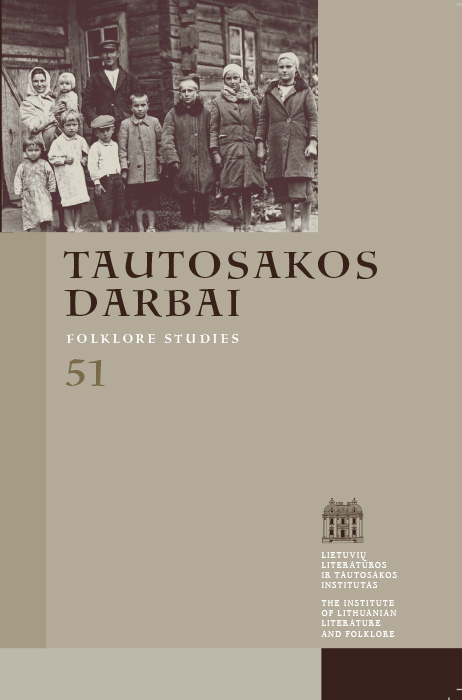Scaring of Children in the Traditional Lithuanian Worldview
Abstract
By scaring, the author means short phrases uttered by the grown-ups in order to encourage acceptable behavior of kids, e.g. ‘If you walk by the rye field, rusalka will come out and take you away’ (LII ES 508/77 p. 153). This phenomenon of Lithuanian folklore, pedagogics and culture in general has hitherto attracted not enough scholarly attention; therefore, this article aims at elucidating its most important features and forms of expression.
It is not entirely clear, to what folklore genre these forms of scaring should belong. They are close to folk beliefs in terms of their typical structure and manifestations of mythical worldview. However, the scaring presents reaction to certain situations and circumstances, thus being similar to situational sayings. Quite frequently, such occurrences stem from a broader social and mythological background, therefore being capable of evolving into folk legends or ritual-like imitation practices.
The scaring of children functions on a twofold basis. Since scaring describes the surroundings and the applicable rules of behavior, it embodies the sensual experience. Children can experience some scary subjects directly (seeing them), while perceiving others through their mythical dwelling places (darkness, reflection in the well, the wavy rye, etc.) or sounds. The diminished possibilities of sensual experience and the obscurity determine the mythical code present in the scaring of children. The opposition between one’s own vs. foreign also plays an important role here: the foreign things tend to be more mythologized and frightening. The relation to reality makes scaring effective here and now, while mythical level encourages children’s imagination and curiosity, making the scaring remarks very catchy.
The scaring very much depends on the situation and changes easily; therefore, classifying these instances according to a single criterion is difficult. This article lists four ways of classifying the scaring of children: according to form (the way of presenting the scary things to kids), to the scary subject (what the kids are intimidated with), to the space (how scary things are located in the living surroundings), and to the purpose (what scaring is meant to achieve). Formally, children can be scared with songs (phrases inserted into the lyrics of lullabies), rhymed situational phrases or simple verbal warnings. According to the subject, the material falls into four groups: scaring with no subject (threatening children with physical destruction or some unpleasant physical consequences); threatening with really existing, although mythologized persons (foreigners, beggars, wizards); threatening with mythologized animals; and threatening with mythical beings. According to space, there are also four groups of scaring instances, i.e. those associated with home, yard, close extraneous space, and distant extraneous space. Such scaring reflects psychophysical development of children and their range of spatial movement. The purpose of scaring may include appropriate everyday behavior of children or their ritually meaningful conduct. In the first case, children have to behave appropriately in terms of physiology or social meaning. Besides, by use of such scaring children are kept away from dangerous places (like wells, water pools, forests) or places important to the social welfare are safeguarded from them (including orchids, gardens, crops).
The ritually meaningful scaring depends either on the stage of the child’s development or on the festive periods that require certain norms of behavior.
The scaring of children constituted an inherent part of the Lithuanian peasant life in the second half of the 19th – the first half of the 20th century. Its prime purpose was forming appropriate social behavior of children. The secondary, although no less important, function was shaping their practical knowledge and mythical worldview. The patterns of scaring altered along with the child’s development, adjusting to the circumstances and the child’s physiologic capacities, yet in turn stimulating the psychophysical development of children as well.
Downloads
Most read articles by the same author(s)
- Vita Džekčioriūtė-Medeišienė, Mythical Notion of Mushrooms in Lithuanian Culture , Tautosakos darbai: Vol. 52 (2016)
- Vita Džekčioriūtė-Medeišienė, Mythical Notion of the Children’s Diseases and Their Liminal Expression in the Traditional Lithuanian Worldview , Tautosakos darbai: Vol. 64 (2022)
- Jurga Sadauskienė, Austė Nakienė, Rytis Ambrazevičius, Asta Skujytė-Razmienė, Radvilė Racėnaitė, Gražina Kadžytė, Modesta Liugaitė-Černiauskienė, Vita Džekčioriūtė-Medeišienė, Eligija Garšvienė, Chronicle , Tautosakos darbai: Vol. 54 (2017)
- Austė Nakienė, Daiva Vaitkevičienė, Vita Džekčioriūtė-Medeišienė, Gražina Kadžytė, Aurimas Bačiulis, Vida Savoniakaitė, Lina Būgienė, Chronicle , Tautosakos darbai: Vol. 55 (2018)
- Rūta Žarskienė, Inga Vidugirytė, Asta Skujytė-Razmienė, Gražina Kadžytė, Lina Leparskienė, Vita Džekčioriūtė-Medeišienė, Dalia Zaikauskienė, Chronicle , Tautosakos darbai: Vol. 58 (2019)
- Vita Džekčioriūtė-Medeišienė, Children’s Tales in the Traditional Lithuanian Culture: Purpose of Cruel Elements , Tautosakos darbai: Vol. 62 (2021)
- Jūratė Šlekonytė, Asta Skujytė-Razmienė, Gražina Kadžytė, Austė Nakienė, Vita Džekčioriūtė-Medeišienė, Chronicle , Tautosakos darbai: Vol. 56 (2018)
- Austė Nakienė, Beata Baublinksienė, Aušra Žičkienė, Audronė Gedžiūtė, Vita Džekčioriūtė-Medeišienė, Chronicle , Tautosakos darbai: Vol. 60 (2020)
